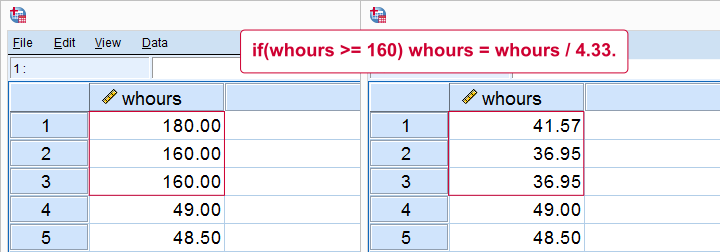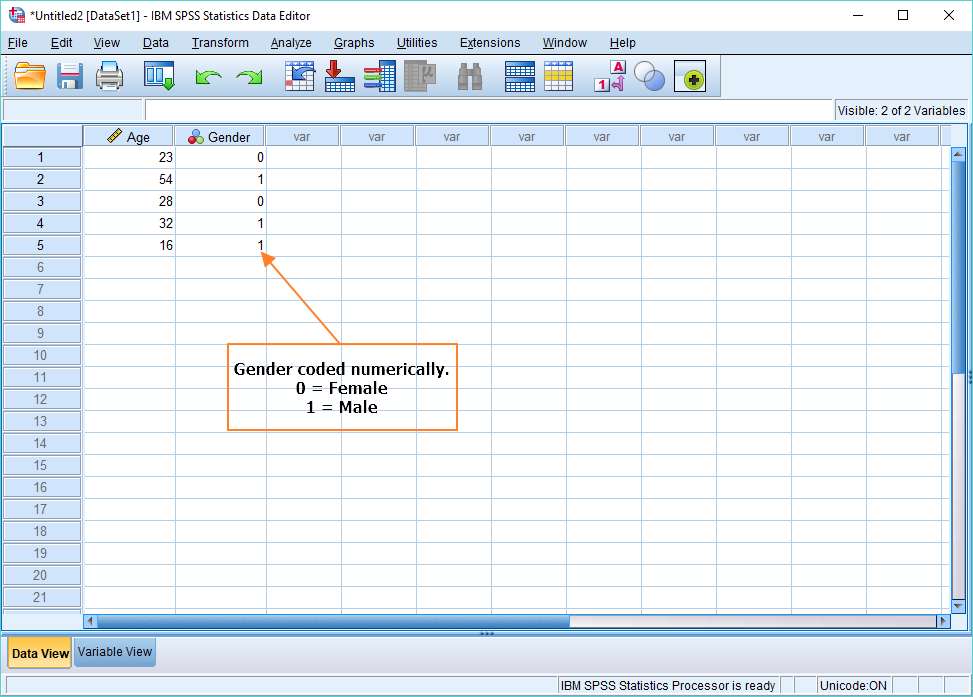
Spss Code To Label New Variable Code Book Right
The program below reads the data and creates a data file called autolab.SPSS Variable Labels and Value Labels are two of the great features of its ability to create a code book right in the data set. This module illustrates how to document data sets in a variety of ways, including creating and using value, variable and dataset labels in SPSS, as well as adding notes regarding the data set. Labeling and documenting data SPSS Learning Modules.
So that ’Underweight, Normal, Overweight, and Obese’ appear in tables and charts rather than the codes 1,2,3 and 4). In the Data Editor window, click the Variable View tab at the bottom.If i have a variable in SPSS, with name (MyVariable), label (My Variable), values(1: Yes, 2: No) etc but without data (the column in data view is empty), i want to add data using syntax For example, i want to add a participant in 1st row, who answered 'Yes', so i want 1 to be addedOnce you have done any recoding / regrouping you may want to switch to variable view to (a) change your new variable so that it has no decimal places and (b) add value labels (e.g. 'If there are no variables or no variables with labels in the current 'document, a warning appears. 'So someone can export a variable to other applications with saving 'his labels. You can get to the Variable View window in two ways:'The script generates a new string variable which values are equal 'to the labels of the source variable. The Variable View tab displays information about the variables in your data.
AUTORECODE VARIABLESv39dr / INTO /name of new variable/ v39new.The Variable View tab displays the following information, in columns, about each variable in your data: NameThe name of the variable, which is used to refer to that variable in syntax. IDsurveyvX.sps for SPSS or IDsurveyvX.do in. This method has the advantage of taking you to the specific variable you clicked.Prepare an empty syntax file (e.g. In the Data Editor window, in the Data View tab, double-click a variable name at the top of the column.
TypeThe type of variable (e.g. Type your new variable name. For example, we may want to rename a variable called Sex to Gender.To change a variable's name, double-click on the name of the variable that you wish to re-name. Renaming a variable simply changes the name of that variable while leaving everything else the same. Note that when you change the name of a variable, it does not change the data all values associated with the variable stay the same.
Then click the "up" or "down" arrow icons to increase or decrease the number width. WidthThe number of digits displayed for numerical values or the length of a string variable.To set a variable's width, click inside the cell corresponding to the “Width” column for that variable. Click the option that best matches the type of variable. A square "." button will appear click on it to open the Variable Type window.
LabelA brief but descriptive definition or display name for the variable. Then click the “up” or “down” arrow icons to increase or decrease the number of decimal places.Example: If you specify that values should have two decimal points, they will display as 1.00, 2.00, 3.00, and so on. Note that this changes how the numbers are displayed, but does not change the values in the dataset.To specify the number of decimal places for a numeric variable, click inside the cell corresponding to the “Decimals” column for that variable. Does not apply to string variables.
Let's define the category labels for the Rank variable in the sample data.Under the column “Values,” click the cell that corresponds to the variable whose values you wish to label. The values 1, 2, 3, 4 represent the categories Freshman, Sophomore, Junior, and Senior, respectively. It is strongly suggested that you give each value a label so that you (and anyone looking at your data or results) understands what each value represents.When value labels are defined, the labels will display in the output instead of the original codes.Note that defining value labels only affects the labels associated with each value, and does not change the recorded values themselves.Example: In the sample dataset, the variable Rank represents the student's class rank. Value labels are useful primarily for categorical (i.e., nominal or ordinal) variables, especially if they have been recorded as codes (e.g., 1, 2, 3). ValuesFor coded categorical variables, the value label(s) that should be associated with each category abbreviation.
When all of the labels have been defined, the Value Labels window should look like this:If you wish to change or remove a value and label that you have added to the center dialog box, do the following: Repeat these steps for each possible value for your variable. Your variable value and label will appear in the center box. Click Add when you are finished defining the value and label. In the Label field type the label exactly as you want it to display (e.g., "Freshman"). The Value Labels window appears.Type the first possible value (1) for your variable in the Value field.

use the Automatic Recode procedure to recode the string variable into a labeled, numeric categorical variable with blanks recoded into a special missing value code.The latter option works well if there are a limited number of unique string values, but is a poor option if there are many unique variations in the strings (e.g. add a space character ( Spacebar key) as a discrete missing value code (either in the Variable View or using syntax), or In order for blanks to be recognized as missing values, you can either: A square button will appear click on it.Click the option that best matches how you wish to define missing data and enter any associated values, then click OK at the bottom of the window.Note that you may enter numbers or letters as discrete missing value codes in the "discrete missing values" boxes.Caution: If you have a dataset with string variables, blank cells are not automatically recognized as missing values. This column merely allows the user to specify up to three unique missing value codes for the given variable or, to specify a range of numbers to treat as missing, plus one additional unique missing value code.To set user-defined missing value codes, click inside the cell corresponding to the “Missing” column for that variable. Note that this property does not alter or eliminate SPSS's default missing value code for numeric variables (".").
AlignThe alignment of content in the cells of the SPSS Data View spreadsheet. Then click the “up” or “down” arrow icons to increase or decrease the column width. This simply refers to the width of the actual column in the spreadsheet.To set a variable's column width, click inside the cell corresponding to the “Columns” column for that variable. Note that this is not the same as the number of digits displayed for each value. ColumnsThe width of each column in the Data View spreadsheet.

Input: The variable will be used as a predictor (independent variable). You can choose from the following roles for each variable: Any variable that meets the role requirements will be available for use in such analyses. Some options in SPSS allow you to pre-select variables for particular analyses based on their defined roles. RoleThe role that a variable will play in your analyses (i.e., independent variable, dependent variable, both independent and dependent).

Variable widthSet the width for one variable: VARIABLE WIDTH var1 (10).Set the same width for multiple variables: VARIABLE WIDTH var1 var2 var3 (10).Set different widths for multiple variables: VARIABLE WIDTH var1 var2 var3 (10)Set the measurement level (nominal, ordinal, or scale) for one or more variables at a time: VARIABLE LEVEL var1 var2 var3 (SCALE).


 0 kommentar(er)
0 kommentar(er)
